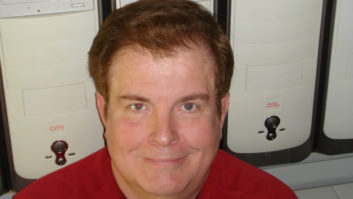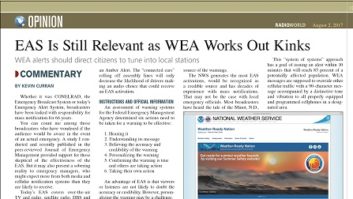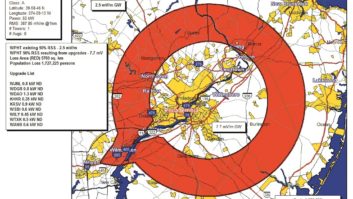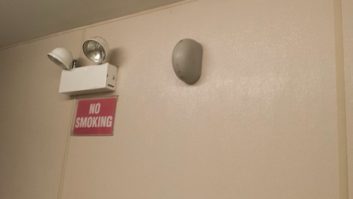The author is a longtime advocate of low-power broadcasting. He has been a government relations attorney since 1975.
The late Nickolaus Leggett and I were very proud of the work we did, in concert with many others, to establish low-power FM community radio.

Credit: iStockphoto/sakkmesterke
Nick passed away in April; you can read my Radio World remembrance of him at http://tinyurl.com/rw-leggett. Looking back, we didn’t achieve all of our LPFM objectives but we reached most of them; and after 14 years of activism, we saw the number of LPFM stations rise from zero to more than 2,000.
Still, Nick and I were haunted by The One That Got Away: a great white whale of an issue that eluded us whatever we tried.
The issue was shielding civilian electronics equipment against an electromagnetic pulse.
DISABLING ELECTRONICS
EMP has been a documented fact of life since 1963, when it displayed itself in the high-altitude test of an American nuclear weapon over the Pacific.
When a nuclear or thermonuclear weapon is detonated at a sufficiently high altitude, in a vacuum or near vacuum, much of the usual heat and blast effects are converted into electromagnetic energy. This pulse can then spread out for literally thousands of miles, instantly disabling electronics equipment from computers to power grids to vehicle ignitions.
If a “rogue nation” and/or a terrorist group can combine a single missile with a single hydrogen warhead, it can paralyze unprotected electronic activity across most of the continental United States. Even a small atomic bomb, such as North Korea now has, can paralyze unprotected electronic activity over a substantial area — such as the West Coast from San Francisco through San Jose, where Silicon Valley is located.
(In the specific case of radio broadcasting, an EMP burst would ionize the atmosphere, blocking radio signals; this would be a temporary problem, disrupting radio service for hours but not longer. The more serious problem would be permanent disabling of radio equipment and/or of the electric power grid that serves broadcasters.)
Further, although a high-altitude nuclear explosion may be the most likely EMP event, EMP can also be generated “naturally” by a sufficiently large solar storm.
In 1986, 23 years after the theory of EMP was proven to be a reality, Nick and I were alarmed by the lack of government action to require any shielding of vital civilian electronics equipment against an EMP.
Joined in this case by Nick’s wife Judith Fielder Leggett, we petitioned the FCC for action in Docket RM-5528. In an effort to be moderate, we sought only a Notice of Inquiry to assess whether any mandatory shielding was needed.
Despite the modesty of our agenda and a post-decision appeal, our petition was denied completely.
In 2001, after the 9/11 attacks, Nick and I decided we couldn’t live with ourselves if we didn’t try again. This time, however, we were more aggressive.
Instead of calling for an NOI, we called for a Notice of Proposed Rulemaking in RM-10330. The commission solicited public comments and received some, but ultimately responded with silence; it neither granted nor denied our proposal. Technically, RM-10330 is still alive and could be a vehicle for FCC action, though the commission has left it in limbo for 16 years so far.
We also tried contacting others, including congressional legislators and technical experts. No one was willing to join us in “rocking the boat.”
Now, as America reaches the 54th anniversary of the first proof of EMP — and the 31st anniversary of the Schellhardt/Leggett Petition in 1986 — North Korea clearly is capable of launching EMP strikes against its Asian neighbors and perhaps against our own West Coast.
Some American leaders hint of launching a “pre-emptive strike” to “disarm” North Korea, but anything less than total success in this attack would leave other nations vulnerable to devastating retaliation. Compared to sustaining the electronic destruction of (for example) metro Seoul, metro Tokyo, metro Kyoto, metro Seattle and Silicon Valley, it would surely be more cost-effective to mandate EMP shielding and expand current missile defenses.
WORTHY WORK
Getting back to the individuals named Leggett and Schellhardt: We often wondered why efforts to promote LPFM succeeded while our efforts to mandate EMP shielding did not.
The answer, I speculate, is that we had allies in the LPFM movement. Not as many as we would have liked, but enough to get the job done.
With the EMP issue, we were never able to find anyone — except ourselves — who was willing to invest real “sweat and tears” in getting results. Indeed, I still don’t see any motivated potential allies on the horizon.
So America has now entered a completely avoidable era of added vulnerability to rogue nations and possibly even terrorist groups (that is, anyone with one nuclear weapon and one missile).
I think back to one of many conversations Nick and I had about a possible afterlife, I believed in one and still do. Nick, ever the scientist, was waiting for more definitive evidence.
Still, he had an open mind. “If there is an afterlife,” he said, “and if there is a God, and I am ever asked what I did to justify the gift of my life on Earth, I intend to reply as follows: ‘Dockets RM-5528 and RM-10330.’”
The author welcomes queries from those interested in pressing for action on EMP shielding at [email protected].
Comment on this or any story. Write to [email protected].












